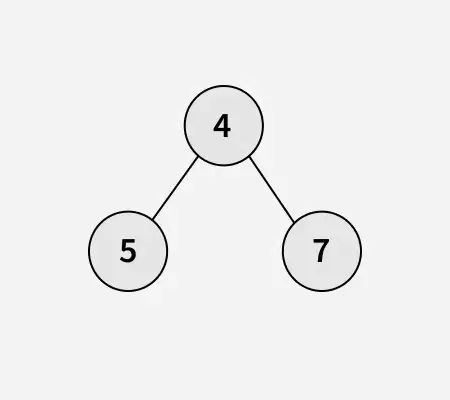Donat un arbre n-ari que conté valors de nodes positius, la tasca és trobar el profunditat de l'arbre.
Nota: An arbre n-ari és un arbre on pot tenir cada node zero o més nodes fills. A diferència d'un arbre binari que té com a màxim dos fills per node (esquerra i dreta) l'arbre n-ari permet múltiples branques o fills per a cada node.
Exemples:
Entrada:
Sortida: 3
Explicació: El camí més llarg des de l'arrel (node 81) fins a una fulla és 81 -> 26 -> 95 o 81 -> 26 -> 86 amb una profunditat màxima de 3.Entrada:

Sortida: 2
Explicació: El camí més llarg des de l'arrel (node 4) fins a qualsevol fulla (nodes 5 o 7) és 2, ja que només requereix dos nivells de recorregut.bous vs bou
Enfocament:
La idea és calcular el profunditat d'un arbre N-ari recursivament inicialitzar el profunditat màxima com a 0, calculeu recursivament el profunditat per a cada nen i fer-ne un seguiment profunditat més alta trobada. Finalment afegir 1 a la profunditat màxima (per al node actual) i retornar el resultat . Aquest enfocament garanteix que trobem el camí més llarg des de l'arrel fins a qualsevol node full.
L'arbre N-Ary es pot travessar igual que un arbre normal. Només hem de considerar tots els fills d'un node donat i cridar recursivament aquesta funció a cada node.
C++// C++ Code to find the depth of an N-ary tree #include
// Java Code to find the depth of an N-ary tree import java.util.*; class Node { int data; List<Node> children; Node(int val) { data = val; children = new ArrayList<>(); } } // Recursive function to calculate // maximum depth class GfG { static int maxDepth(Node root) { // If the node is null depth is 0 if (root == null) { return 0; } int depth = 0; // Recur for all children and find // the maximum depth for (Node child : root.children) { depth = Math.max(depth maxDepth(child)); } // Add 1 to include the current node // in the depth count return depth + 1; } public static void main(String[] args) { // Representation of given N-ary tree // 1 // / | // 2 3 4 // / // 5 6 Node root = new Node(1); root.children.add(new Node(2)); root.children.add(new Node(3)); root.children.add(new Node(4)); root.children.get(0).children.add(new Node(5)); root.children.get(2).children.add(new Node(6)); System.out.println(maxDepth(root)); } }
# Python Code to find the depth # of an N-ary tree class Node: def __init__(self val): self.data = val self.children = [] # Recursive function to calculate # maximum depth def max_depth(root): # If the node is None depth is 0 if not root: return 0 depth = 0 # Recur for all children and # find the maximum depth for child in root.children: depth = max(depth max_depth(child)) # Add 1 to include the current # node in the depth count return depth + 1 if __name__ == '__main__': # Representation of given N-ary tree # 1 # / | # 2 3 4 # / # 5 6 root = Node(1) root.children.append(Node(2)) root.children.append(Node(3)) root.children.append(Node(4)) root.children[0].children.append(Node(5)) root.children[2].children.append(Node(6)) print(max_depth(root))
// C# Code to find the depth of an N-ary tree using System; using System.Collections.Generic; class Node { public int data; public List<Node> children; public Node(int val) { data = val; children = new List<Node>(); } } // Recursive function to calculate // maximum depth class GfG { static int MaxDepth(Node root) { // If the node is null depth is 0 if (root == null) { return 0; } int depth = 0; // Recur for all children and find the maximum depth foreach (Node child in root.children) { depth = Math.Max(depth MaxDepth(child)); } // Add 1 to include the current // node in the depth count return depth + 1; } static void Main(string[] args) { // Representation of given N-ary tree // 1 // / | // 2 3 4 // / // 5 6 Node root = new Node(1); root.children.Add(new Node(2)); root.children.Add(new Node(3)); root.children.Add(new Node(4)); root.children[0].children.Add(new Node(5)); root.children[2].children.Add(new Node(6)); Console.WriteLine(MaxDepth(root)); } }
// JavaScript Code to find the depth // of an N-ary tree class Node { constructor(val) { this.data = val; this.children = []; } } // Recursive function to calculate // maximum depth function maxDepth(root) { // If the node is null depth is 0 if (!root) { return 0; } let depth = 0; // Recur for all children and find // the maximum depth for (let child of root.children) { depth = Math.max(depth maxDepth(child)); } // Add 1 to include the current node // in the depth count return depth + 1; } // Representation of given N-ary tree // 1 // / | // 2 3 4 // / // 5 6 const root = new Node(1); root.children.push(new Node(2)); root.children.push(new Node(3)); root.children.push(new Node(4)); root.children[0].children.push(new Node(5)); root.children[2].children.push(new Node(6)); console.log(maxDepth(root));
Sortida
3
Complexitat temporal: O(n) ja que cada node es visita una vegada, on n és el nombre total de nodes de l'arbre N-ari.
Espai auxiliar: O(h) on h és l'alçada de l'arbre a causa de l'ús recursiu de la pila de trucades.


